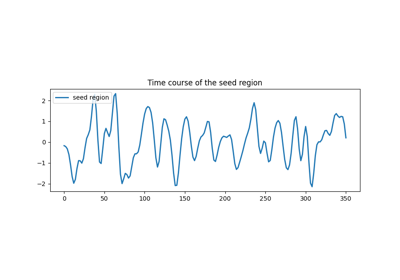Note
This page is a reference documentation. It only explains the function signature, and not how to use it. Please refer to the user guide for the big picture.
nilearn.glm.first_level.make_first_level_design_matrix¶
- nilearn.glm.first_level.make_first_level_design_matrix(frame_times, events=None, hrf_model='glover', drift_model='cosine', high_pass=0.01, drift_order=1, fir_delays=None, add_regs=None, add_reg_names=None, min_onset=-24, oversampling=50)[source]¶
Generate a design matrix from the input parameters.
- Parameters:
- frame_timesarray of shape (n_frames,)
The timing of acquisition of the scans in seconds.
- events
pandas.DataFrameinstance, orstrorpathlib.Pathto a CSV or TSV file, or None, default=None Events data that describes the experimental paradigm. The resulting DataFrame instance must/may have these keys:
'onset': REQUIREDColumn to specify the start time of each events in seconds. An error is raised if this key is missing.
'duration': REQUIREDColumn to specify the duration of each events in seconds.
Warning
Events with a duration of 0 seconds will be modeled using a ‘delta function’.
'trial_type': OPTIONALColumn to specify per-event experimental conditions identifier. If missing each event are labeled ‘dummy’ and considered to form a unique condition.
'modulation': OPTIONALColumn to specify the amplitude of each events. If missing the default is set to ones(n_events).
An experimental paradigm is valid if it has an
'onset'key and a'duration'key. If these keys are missing an error will be raised. For the others keys a warning will be displayed. Particular attention should be given to the'trial_type'key which defines the different conditions in the experimental paradigm.- hrf_model
str, function,listof functions, or None This parameter defines the HRF model to be used. It can be a string if you are passing the name of a model implemented in Nilearn. Valid names are:
"spm + derivative": SPM model plus its time derivative. This gives 2 regressors. Seespm_hrf, andspm_time_derivative."spm + derivative + dispersion": Same as above plus dispersion derivative. This gives 3 regressors. Seespm_hrf,spm_time_derivative, andspm_dispersion_derivative."glover": This corresponds to the Glover HRF. Seeglover_hrf."glover + derivative": The Glover HRF + time derivative. This gives 2 regressors. Seeglover_hrf, andglover_time_derivative."glover"+ derivative + dispersion": Same as above plus dispersion derivative. This gives 3 regressors. Seeglover_hrf,glover_time_derivative, andglover_dispersion_derivative."fir": Finite impulse response basis. This is a set of delayed dirac models.
It can also be a custom model. In this case, a function should be provided for each regressor. Each function should behave as the other models implemented within Nilearn. That is, it should take both
t_randoversamplingas inputs and return a sample numpy array of appropriate shape.Note
It is expected that
"spm"standard and"glover"models would not yield large differences in most cases.Note
In case of
"glover"and"spm"models, the derived regressors are orthogonalized with respect to the main one.- drift_model{‘cosine’, ‘polynomial’, None}, default=’cosine’
Specifies the desired drift model.
- high_pass
float, default=0.01 High-pass frequency in case of a cosine model (in Hz).
- drift_order
int, default=1 Order of the drift model (in case it is polynomial).
- fir_delaysarray of shape(n_onsets),
listor None, default=None Will be set to
[0]ifNoneis passed. In case of FIR design, yields the array of delays used in the FIR model (in scans).- add_regsarray of shape(n_frames, n_add_reg) or pandas DataFrame or None, default=None
additional user-supplied regressors, e.g. data driven noise regressors or seed based regressors.
- add_reg_names
listof (n_add_reg,)str, or None, default=None If None, while add_regs was provided, these will be termed ‘reg_i’, i = 0..n_add_reg - 1 If add_regs is a DataFrame, the corresponding column names are used and add_reg_names is ignored.
- min_onset
float, default=-24 Minimal onset relative to frame_times[0] (in seconds) events that start before frame_times[0] + min_onset are not considered.
- oversampling
int, default=50 Oversampling factor used in temporal convolutions.
- Returns:
- design_matrixDataFrame instance,
holding the computed design matrix, the index being the frames_times and each column a regressor.

